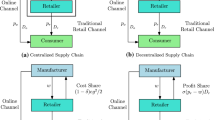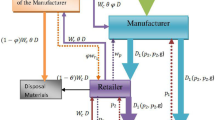Abstract
Due to the advancement of online marketing, many manufacturers have started to provide a return policy with refund agreements. This paper concerns return policy in a dual-channel supply green chain, wherein customers can buy the products through a traditional retail channel or direct online channel. Under sustainable improvement, we have developed the dual-channel supply chain system with a return strategy including refund via direct online channel. Market demand is dependent on product sales price, green label, and refund amount. Firstly, the supply chain members target to optimize their decision variables under a centralized decision model. Secondly, the entire supply chain members make their decision individually to maximize the overall profit using the non-cooperative Stackelberg game approach. The prime objectives of the paper are to find out the optimal sales price, wholesale price, green label, and refund price so that the profit of the supply chain will be maximized. By solving the game model, we compare the optimal decision under both scenarios and implement sensitivity observation, which helps to reflect the influence of critical parameters.
Access this chapter
Tax calculation will be finalised at checkout
Purchases are for personal use only
Similar content being viewed by others
References
Barman, A., Das, R., & De, P. K. (2021a). Optimal pricing and greening decision in a manufacturer retailer dual-channel supply chain. Materials Today: Proceedings.
Barman, A., Das, R., & De, P. K. (2021b). An analysis of optimal pricing strategy and inventory scheduling policy for a non-instantaneous deteriorating item in a two-layer supply chain. Applied Intelligence, 1–25.
Barman, A., Das, R., De, P. K., & Sana, S. S. (2021). Optimal pricing and greening strategy in a competitive green supply chain: Impact of government subsidy and tax policy. Sustainability, 13(16), 9178.
Das, R., Barman, A., & De, P. K. (2021a). Integration of pricing and inventory decisions of deteriorating item in a decentralized supply chain: A Stackelberg-game approach. International Journal of System Assurance Engineering and Management, 1–15.
Das, R., De, P. K., & Barman, A. (2021b). Pricing and ordering strategies in a two-echelon supply chain under price discount policy: A Stackelberg game approach. Journal of Management Analytics, 1–27.
Ghosh, D., & Shah, J. (2012). A comparative analysis of greening policies across supply chain structures. International Journal of Production Economics, 135(2), 568–583.
Ghosh, P. K., Manna, A. K., Dey, J. K., & Kar, S. (2021). Supply chain coordination model for green product with different payment strategies: A game theoretic approach. Journal of Cleaner Production, 290, 125734.
Giri, B. C., & Bardhan, S. (2015). Coordinating a supply chain under uncertain demand and random yield in presence of supply disruption. International Journal of Production Research, 53(16), 5070–5084.
Heydari, J., Govindan, K., & Aslani, A. (2019). Pricing and greening decisions in a three-tier dual channel supply chain. International Journal of Production Economics, 217, 185–196.
Li, B., Zhu, M., Jiang, Y., & Li, Z. (2016). Pricing policies of a competitive dual-channel green supply chain. Journal of Cleaner Production, 112, 2029–2042.
Mondal, C., & Giri, B. C. (2020). Pricing and used product collection strategies in a two-period closed-loop supply chain under greening level and effort dependent demand. Journal of Cleaner Production, 265, 121335.
Mostard, J., & Teunter, R. (2006). The newsboy problem with resalable returns: A single period model and case study. European Journal of Operational Research, 169(1), 81–96.
Navinchandra, D. (1990). Steps toward environmentally compatible product and process design: A case for green engineering. Technical report, CARNEGIE-MELLON UNIV PITTSBURGH PA ROBOTICS INST.
Rahmani, K., & Yavari, M. (2019). Pricing policies for a dual-channel green supply chain under demand disruptions. Computers & Industrial Engineering, 127, 493–510.
Roy, J., Pamučar, D., & Kar, S. (2020). Evaluation and selection of third party logistics provider under sustainability perspectives: An interval valued fuzzy-rough approach. Annals of Operations Research, 293(2), 669–714.
Srivastava, S. K. (2007). Green supply-chain management: A state-of-the-art literature review. International Journal of Management Reviews, 9(1), 53–80.
Taleizadeh, A. A., Moshtagh, M. S., & Moon, I. (2018). Pricing, product quality, and collection optimization in a decentralized closed-loop supply chain with different channel structures: Game theoretical approach. Journal of Cleaner Production, 189, 406–431.
Taleizadeh, A. A., Beydokhti, S. R., Cárdenas-Barrón, L. E., & Najafi-Ghobadi, S. (2021). Pricing of complementary products in online purchasing under return policy. Journal of Theoretical and Applied Electronic Commerce Research, 16(5), 1718–1739.
Wu, Z., & Wu, J. (2015). Price discount and capacity planning under demand postponement with opaque selling. Decision Support Systems, 76, 24–34.
Yoo, S. H. (2014). Product quality and return policy in a supply chain under risk aversion of a supplier. International Journal of Production Economics, 154, 146–155.
Zhou, Y., Bao, M., Chen, X., & Xu, X. (2016). Co-op advertising and emission reduction cost sharing contracts and coordination in low-carbon supply chain based on fairness concerns. Journal of Cleaner Production, 133, 402–413.
Author information
Authors and Affiliations
Corresponding author
Editor information
Editors and Affiliations
Rights and permissions
Copyright information
© 2023 The Author(s), under exclusive license to Springer Nature Singapore Pte Ltd.
About this paper
Cite this paper
De, P.K., Chakraborty, A.K., Barman, A., Das, R. (2023). Strategic Analysis of a Dual Channel Green Supply Chain with Return-Refund Facility. In: Gunasekaran, A., Sharma, J.K., Kar, S. (eds) Applications of Operational Research in Business and Industries. Lecture Notes in Operations Research. Springer, Singapore. https://doi.org/10.1007/978-981-19-8012-1_19
Download citation
DOI: https://doi.org/10.1007/978-981-19-8012-1_19
Published:
Publisher Name: Springer, Singapore
Print ISBN: 978-981-19-8011-4
Online ISBN: 978-981-19-8012-1
eBook Packages: Business and ManagementBusiness and Management (R0)




